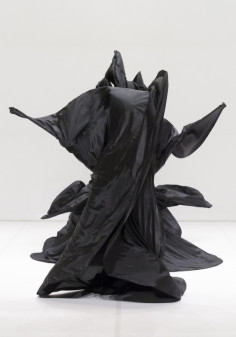OLA MACIEJEWSKA
BOMBYX MORI

source:olamaciejewskacarbonmadecom
In BOMBYX MORI Ola Maciejewska playfully transforms Loie Fuller: Research form 2011 into a choreographic work performed by 3 dancers.
As the ‘Dancing Dress’ of Loie Fuller (1862-1928) unfolds, BOMBYX MORI pronounces a new critical potential of that action. With this work Ola Maciejewska won’t replicate the hypnotic serpentine like swirls, what is at stake is the relation between the body and the artifact. While dance history, as we know it, predominantly positions the body as the main source of movement, the American pioneer was one of the first ones to speak of movement outside of the body, a movement as a result of the interactions between body and things (lights, materials, sound). In BOMBYX MORI, as the dramaturgical development of intensity in time reveals: forms, instant freezes, shape shifts, and outbursts of energized matter, it is beyond doubt that the work resists a way of reading these as simple reference, in this project ‘shapes reading’ is intentionally being sabotaged. The onlooker is guided to overcome the binary divisions standing over against one another, like: body/object, physical/non-physical, human/non-human, rational beings and irresponsible creatures… Like the silk worm: bombyx mori, who literally works on the verge of binaries, who’s existence is to be between, appears here to produce a visual reflection on hybrid nature of things.
.
.
.
.
.
.
.
source:kaaitheaterbe
Loïe Fuller (1862-1928) was a performance artist before the term was even invented: innovative and impossible to categorise. She made her name with solos in which she turned in circles, draping metres of silk fabric around her body. She fits within the art nouveau movement, but was equally at home dancing at the Folies Bergère. By being the first person to make use of electric light and to position movement outside the body, she was an innovative force in both the dance and theatre worlds. She collaborated with figures such as Auguste Rodin and the Lumière brothers.
In this piece for three dancers, Ola Maciejewska draws her inspiration from Fuller’s Serpentine Dance. She explores the relationship in the arts between human beings and physical matter by creating movement in large pieces of fabric. She plays with the confluence of bodies and objects and the battle that these wage. Bombyx Mori alludes to the silk caterpillar, which has become entirely dependent on human beings for survival. Here, the natural body and the artificial process are inextricably linked: a poignant metaphor for this sculptural interpretation of one of the pioneers of modern dance and performance art.
.
.
.
.
.
.
.
source:theatredelacitecom
En 1895, Loïe Fuller dépose un brevet d’invention pour « une nouvelle combinaison de robe destinée à la danse théâtrale ». Cette robe aérienne, que Fuller ne cessera de perfectionner, est une vaste corolle de soie blanche.
Deux baguettes (de bambou puis d’aluminium) lui permettent de prolonger ses mains et d’imprimer des mouvements virtuoses au tissu. C’est de cette robe dont Ola Maciejewska et son spectacle Bombyx Mori gardent le souvenir.
Ici, les robes sont noires et les danseurs sont trois sur le plateau, mais les mêmes métamorphoses affolantes, liées à la force centrifuge des mouvements imprimés au tissu, ébahissent l’œil du spectateur. Maciejewska et ses danseurs jouent de cette machinerie de tissu et engagent avec elle une conversation presque humaine qui leur permettent de comprendre comment cette machine veut être traitée plutôt que de lui imposer des gestes extérieurs.
Le corps peut ainsi devenir objet et la matière un sujet autonome, et tous les deux se transformer en créature hybride, en des figures étranges.
.
.
.
.
.
.
.
source:mercatflorscat
La Poderosa trae al Mercat Hacer Historia (s), un ciclo que quiere mirar atrás fruto de la necesidad y del deseo de construir la historia desde su propia mirada: CUERPO, MEMORIA, ARCHIVO, TRANSMISIÓN, HISTORIA. En este marco veremos una re_visión de la coreógrafa internacional Ola Maciejewska, que trabaja con el deseo de archivo y de experimentación recreando a una de las coreógrafas más importantes del siglo pasado, Loie Fuller. Bailarina, actriz, productora y escritora norteamericana, Fuller destacó en concentrarse en los efectos visuales.
Ola Maciejewska presenta Bombyx Mori, donde la creadora habla del movimiento como resultado de las interacciones entre el cuerpo y las cosas (luces, materiales, sonido). Explora a través de tres bailarines los límites de la capacidad humana y la capacidad de un objeto en acción. Paralelamente tendrá lugar una conversación entre Ola Maciejewska y el dramaturgo y teórico de danza Roberto Fratini.
.
.
.
.
.
.
.
source:dertheaterverlagde
Hinter dem dunklen Wirbeln von «Bombyx mori», einem Trio der polnisch-französischen Choreografin Ola Maciejewska, verbirgt sich eine göttliche Geschichte: In der ägyptischen Mythologie entstand das Jenseits als Folge des Mordes an Osiris durch seinen finsteren Bruder Seth. Dieser verteilte die zerstückelte Leiche des Opfers über das gesamte Gebiet Ägyptens. Osiris’ Gemahlin Isis suchte so lange nach den Teilen, bis sie den Körper wieder zusammenfügen konnte.
Isis, Göttin der Geburt wie des Totenreichs, wurde häufig mit Flügeln an den Armen dargestellt. Nun sind im populären orientalischen Tanz seit Ende des vorigen Jahrhunderts seidene Isis-Flügel, die an mit Stöcken verlängerten Armen flattern, wieder in Mode. Was auch als Reminiszenz an Loïe Fullers Serpentinentanz gelesen werden kann, der im Europa des Fin de Siècle Begeisterungsstürme auslöste.
Die Amerikanerin hatte damals diesen Schleiertanz, bei dem der Körper im Wirbel der Isis-Schwingen für Momente völlig verschwand, erfunden und mit schillernden Farbenspielen zu wahren Wunderwerken gesteigert. Deren Schatten beschwört Maciejewska nun herauf. Sie spinnt Fuller mit «Bombyx mori» lateinische Bezeichnung für den Seidenspinner .

